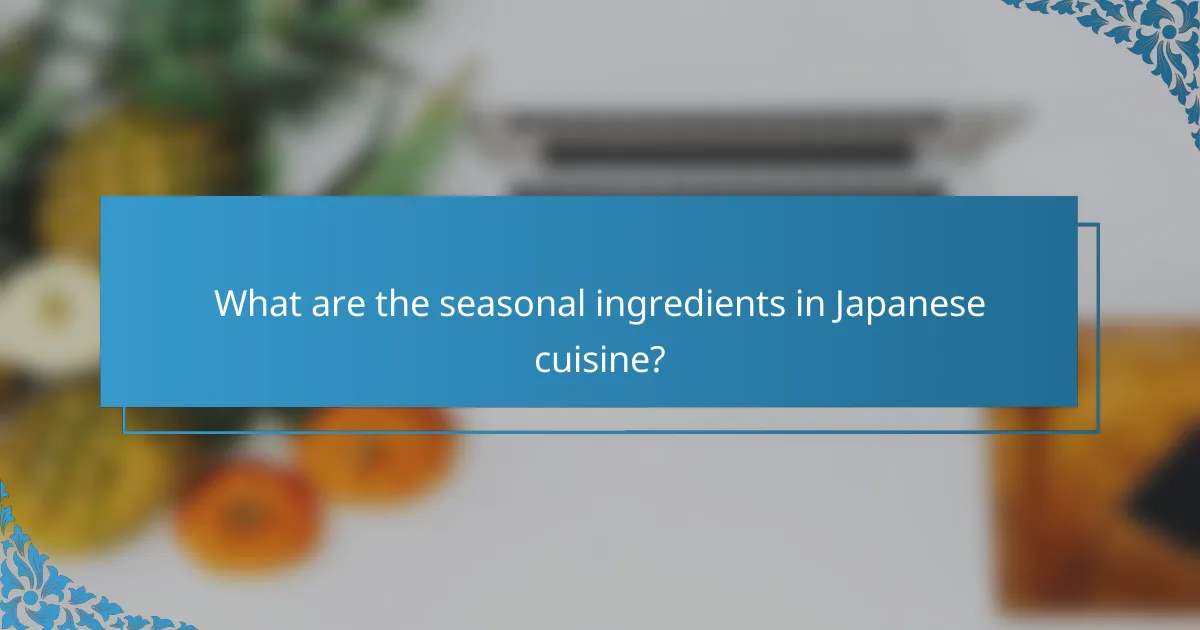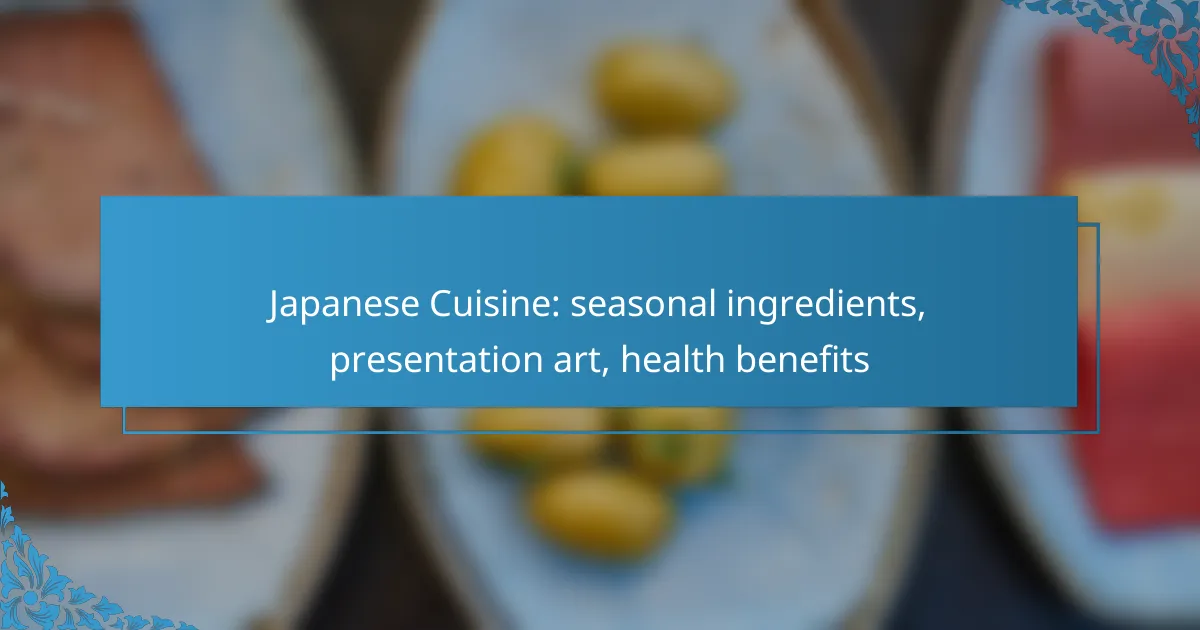Japanese cuisine is a harmonious blend of seasonal ingredients, artful presentation, and health benefits. By utilizing fresh, locally-sourced produce, each dish reflects the changing seasons and offers unique flavors and nutritional advantages. The meticulous arrangement of food not only showcases culinary skill but also enhances the overall dining experience, while the focus on balanced nutrition promotes well-being and longevity.

What are the seasonal ingredients in Japanese cuisine?
Seasonal ingredients in Japanese cuisine are key to creating dishes that reflect the natural rhythms of the environment. These ingredients vary throughout the year, offering unique flavors and nutritional benefits that enhance the dining experience.
Spring ingredients like sakura and bamboo shoots
In spring, sakura (cherry blossoms) and bamboo shoots are prominent ingredients. Sakura is often used to flavor sweets and teas, providing a delicate floral note. Bamboo shoots, harvested young, have a crunchy texture and are commonly used in stir-fries and soups.
Other spring ingredients include peas and fava beans, which add freshness to dishes. Utilizing these seasonal items not only enhances flavor but also supports local agriculture.
Summer ingredients such as eggplant and tomatoes
Summer brings a bounty of vibrant vegetables, with eggplant and tomatoes taking center stage. Japanese eggplant, known for its tender skin and mild flavor, is often grilled or used in miso dishes. Tomatoes, particularly the heirloom varieties, are enjoyed fresh in salads or as a base for sauces.
Additionally, summer is the season for refreshing dishes like cold soba noodles, often served with dipping sauces that highlight the season’s produce. Incorporating these ingredients can make meals lighter and more hydrating during the warmer months.
Autumn ingredients including mushrooms and sweet potatoes
Autumn is characterized by the harvest of mushrooms and sweet potatoes. Varieties such as shiitake and enoki mushrooms are celebrated for their umami flavors and are often featured in soups and hot pots. Sweet potatoes, particularly the Japanese satsumaimo, are sweet and starchy, perfect for roasting or making desserts.
This season also brings a variety of root vegetables, which can be used in hearty dishes that warm the body as temperatures drop. Emphasizing these ingredients can create comforting meals that reflect the season’s bounty.
Winter ingredients like daikon and yuzu
In winter, daikon radish and yuzu citrus are essential components of Japanese cuisine. Daikon is often used in stews and pickles, providing a mild flavor and crunchy texture. Its versatility makes it a staple during colder months.
Yuzu, with its aromatic zest and tart juice, is used in dressings, marinades, and desserts, adding brightness to winter dishes. Utilizing these ingredients can enhance the warmth and comfort of meals during the chilly season.

How is presentation art important in Japanese cuisine?
Presentation art is crucial in Japanese cuisine as it enhances the dining experience by appealing to the senses and reflecting cultural values. The visual arrangement of food not only showcases the chef’s skill but also emphasizes the seasonality and freshness of the ingredients used.
Use of color and balance in plating
In Japanese cuisine, the use of color and balance in plating is essential for creating visually appealing dishes. Chefs often employ a harmonious combination of colors, such as vibrant greens, rich reds, and soft whites, to stimulate the appetite and create a sense of balance. For instance, a dish may feature bright green vegetables alongside deep red fish to create contrast and attract attention.
Achieving balance involves not just color but also the arrangement of food items on the plate. A well-composed dish might follow the principle of “one-third” for protein, “one-third” for vegetables, and “one-third” for starch, ensuring that each component is visually distinct yet cohesive.
Seasonal themes in presentation
Seasonal themes play a significant role in the presentation of Japanese cuisine, reflecting the changing seasons and the ingredients available at different times of the year. Dishes are often designed to evoke the essence of a particular season, such as cherry blossoms in spring or autumn leaves in fall. This connection to nature enhances the overall dining experience and appreciation for the ingredients.
For example, a spring dish may feature sakura (cherry blossom) motifs, while autumn presentations might include earthy tones and leaf shapes. This seasonal approach not only highlights freshness but also reinforces cultural traditions and the importance of nature in Japanese life.
Traditional serving ware and aesthetics
The choice of traditional serving ware is integral to the presentation art in Japanese cuisine. Plates, bowls, and utensils are often selected based on their aesthetic appeal and how they complement the food. Materials such as ceramic, lacquer, and bamboo are commonly used, each adding a unique texture and color to the dining experience.
Additionally, the aesthetics of the serving ware can enhance the overall theme of the meal. For instance, a rustic, hand-crafted bowl may be used for a simple, home-cooked dish, while elegant porcelain might be reserved for more formal occasions. This careful selection underscores the importance of harmony between food and its presentation, creating a holistic dining experience.

What are the health benefits of Japanese cuisine?
Japanese cuisine offers numerous health benefits, primarily due to its focus on fresh, seasonal ingredients and balanced nutrition. The traditional diet emphasizes low-calorie, nutrient-rich foods that support overall well-being and longevity.
Low-calorie and nutrient-dense ingredients
Many Japanese dishes are crafted using low-calorie ingredients such as vegetables, tofu, and seafood, making them ideal for those looking to maintain a healthy weight. Staples like rice and noodles are often served in moderation, allowing for a balanced intake of calories.
Incorporating a variety of seasonal vegetables, such as daikon radish and shiso leaves, enhances the nutrient profile of meals. These ingredients provide essential vitamins and minerals while keeping calorie counts low, promoting a healthy lifestyle.
Rich in omega-3 fatty acids from fish
Japanese cuisine frequently features fish, particularly fatty varieties like salmon and mackerel, which are rich in omega-3 fatty acids. These healthy fats are known to support heart health, reduce inflammation, and improve brain function.
Regular consumption of fish can help meet dietary recommendations for omega-3 intake, which is often suggested to be around 250-500 mg per day for optimal health. Including fish in meals several times a week can contribute significantly to these beneficial fatty acid levels.
High antioxidant levels in vegetables
Japanese meals often include a variety of colorful vegetables that are high in antioxidants, such as green tea, seaweed, and sweet potatoes. Antioxidants help combat oxidative stress and may reduce the risk of chronic diseases.
To maximize antioxidant intake, aim to include a mix of raw and cooked vegetables in your diet. For instance, enjoying a salad with fresh greens and a side of steamed vegetables can enhance nutrient absorption and overall health benefits.

How does Japanese cuisine reflect local culture?
Japanese cuisine embodies local culture through its emphasis on seasonal ingredients, regional specialties, and artistic presentation. Each dish tells a story, showcasing the unique flavors and traditions of its area, while also promoting health and well-being.
Regional specialties across Japan
Japan’s diverse geography leads to a wide variety of regional specialties, each influenced by local climate, agriculture, and fishing practices. For example, Hokkaido is renowned for its fresh seafood and dairy products, while Kyoto is famous for its kaiseki cuisine, which emphasizes seasonal vegetables and delicate flavors.
In addition to these, Okinawa is known for its longevity diet, featuring sweet potatoes and fresh fish, which reflects the island’s unique cultural heritage. Each region’s specialties not only highlight local ingredients but also preserve traditional cooking methods and recipes passed down through generations.
Influence of festivals and traditions on dishes
Festivals and traditions play a significant role in shaping Japanese cuisine, as many dishes are prepared specifically for seasonal celebrations. For instance, during the New Year, families often enjoy osechi ryori, a beautifully arranged assortment of foods that symbolize prosperity and happiness.
Moreover, traditional events like Hanami, the cherry blossom viewing, inspire seasonal dishes such as sakura mochi, a sweet rice cake wrapped in cherry leaves. These culinary practices not only celebrate the seasons but also reinforce community bonds and cultural identity through shared meals and rituals.

What are the key cooking techniques in Japanese cuisine?
Japanese cuisine employs various cooking techniques that highlight the freshness and quality of seasonal ingredients. Key methods include sushi making, tempura frying, and grilling or steaming, each with unique approaches and considerations.
Sushi making techniques
Sushi making involves several techniques that focus on the quality of rice and fish. The rice, or shari, is seasoned with a mixture of vinegar, sugar, and salt, and must be cooked to the right texture—sticky yet firm. Fish should be sliced precisely, often against the grain, to enhance its tenderness.
Common types of sushi include nigiri, where rice is molded by hand and topped with fish, and maki, where rice and fillings are rolled in seaweed. Practicing proper knife skills and understanding the balance of flavors are essential for creating authentic sushi.
Tempura frying methods
Tempura is a popular Japanese dish that features lightly battered and deep-fried vegetables or seafood. The batter is typically made from cold water and flour, which helps achieve a light, crispy texture. It is crucial to maintain the oil temperature between 160-180°C (320-356°F) for optimal frying.
To avoid sogginess, ingredients should be dry before battering, and frying should be done in small batches to prevent temperature drops. Serve tempura immediately after frying for the best experience.
Grilling and steaming practices
Grilling in Japanese cuisine often involves techniques like yakitori, where skewered chicken is grilled over charcoal, imparting a smoky flavor. The key is to use high-quality ingredients and to baste with tare sauce for added depth. Grilling should be done at medium heat to ensure even cooking without burning.
Steaming, on the other hand, is a gentle cooking method that preserves the natural flavors and nutrients of ingredients. Commonly used for dishes like chawanmushi (savory egg custard), steaming requires careful timing and the right equipment, such as a bamboo steamer or a steamer pot. Both methods emphasize the importance of ingredient quality and preparation techniques in Japanese cooking.

How do seasonal ingredients impact menu planning in Japanese restaurants?
Seasonal ingredients play a crucial role in menu planning for Japanese restaurants, influencing both the flavor profiles and the overall dining experience. By incorporating fresh, in-season produce, chefs can create dishes that reflect the changing seasons, enhancing authenticity and appeal.
Creating seasonal specials
Creating seasonal specials allows restaurants to showcase the best ingredients available at any given time. For example, spring might feature dishes with bamboo shoots and sakura (cherry blossoms), while autumn could highlight mushrooms and chestnuts. These specials not only attract customers looking for unique dining experiences but also promote sustainability by using local produce.
When designing seasonal specials, consider the visual presentation as well. Japanese cuisine emphasizes aesthetics, so incorporating vibrant colors and artistic plating can elevate the appeal of seasonal dishes. This approach can lead to increased customer satisfaction and repeat visits.
Adjusting ingredient sourcing based on seasons
Adjusting ingredient sourcing based on seasons is essential for maintaining quality and flavor in Japanese cuisine. Chefs should establish relationships with local farmers and suppliers to ensure access to the freshest seasonal produce. This not only supports the local economy but also reduces transportation costs and environmental impact.
Restaurants should also be aware of seasonal availability when planning their menus. For instance, certain fish varieties may be more abundant during specific months, impacting pricing and quality. Regularly updating the menu to reflect these changes can help maintain a competitive edge and keep the dining experience fresh for patrons.

What are the emerging trends in Japanese cuisine?
Emerging trends in Japanese cuisine focus on sustainability, health-conscious ingredients, and innovative presentation techniques. Chefs are increasingly incorporating seasonal produce and traditional methods while exploring fusion elements to appeal to modern palates.
Seasonal Ingredients
Seasonal ingredients are central to Japanese cuisine, emphasizing freshness and flavor. Chefs often highlight local produce that varies throughout the year, such as sakura (cherry blossoms) in spring and matsutake mushrooms in autumn. This approach not only enhances taste but also supports local agriculture.
Using seasonal ingredients can also promote health benefits, as these foods are typically harvested at their peak nutritional value. For example, incorporating fresh fish during the summer months can provide essential omega-3 fatty acids, while root vegetables in winter offer hearty sustenance.
Presentation Art
Presentation art in Japanese cuisine is a vital aspect that elevates the dining experience. Dishes are often arranged to reflect the beauty of nature, using colors, shapes, and textures to create visual harmony. Techniques such as using lacquerware or ceramic plates enhance the aesthetic appeal.
Chefs may employ minimalist designs to focus attention on the food itself, often using garnishes like edible flowers or finely sliced vegetables to add elegance. This artistic approach not only pleases the eye but also engages diners, making meals memorable.
Health Benefits
Japanese cuisine is renowned for its health benefits, largely due to its emphasis on fresh, unprocessed ingredients. Meals typically include a variety of vegetables, fish, and fermented foods, which contribute to a balanced diet. For instance, miso soup is rich in probiotics, promoting gut health.
Additionally, traditional Japanese meals often feature smaller portion sizes, which can aid in weight management. By focusing on nutrient-dense foods and mindful eating practices, Japanese cuisine supports overall well-being while providing delicious flavors.
